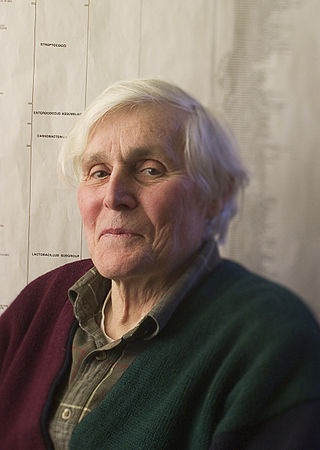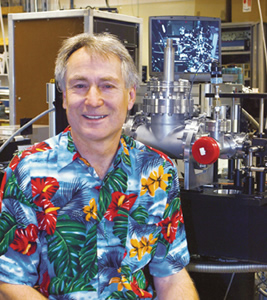
Carl Woese was an American microbiologist and biophysicist. Woese is famous for defining the Archaea in 1977 through a pioneering phylogenetic taxonomy of 16S ribosomal RNA, a technique that has revolutionized microbiology. He also originated the RNA world hypothesis in 1967, although not by that name. Woese held the Stanley O. Ikenberry Chair and was professor of microbiology at the University of Illinois Urbana–Champaign.

Sir Michael Victor Berry, is a British mathematical physicist at the University of Bristol, England.
In physics, critical phenomena is the collective name associated with the physics of critical points. Most of them stem from the divergence of the correlation length, but also the dynamics slows down. Critical phenomena include scaling relations among different quantities, power-law divergences of some quantities described by critical exponents, universality, fractal behaviour, and ergodicity breaking. Critical phenomena take place in second order phase transitions, although not exclusively.

Kenneth Geddes "Ken" Wilson was an American theoretical physicist and a pioneer in leveraging computers for studying particle physics. He was awarded the 1982 Nobel Prize in Physics for his work on phase transitions—illuminating the subtle essence of phenomena like melting ice and emerging magnetism. It was embodied in his fundamental work on the renormalization group.

Artur Konrad Ekert is a British-Polish professor of quantum physics at the Mathematical Institute, University of Oxford, professorial fellow in quantum physics and cryptography at Merton College, Oxford, Lee Kong Chian Centennial Professor at the National University of Singapore and the founding director of the Centre for Quantum Technologies (CQT). His research interests extend over most aspects of information processing in quantum-mechanical systems, with a focus on quantum communication and quantum computation. He is best known as one of the pioneers of quantum cryptography.

Leo Philip Kadanoff was an American physicist. He was a professor of physics at the University of Chicago and a former president of the American Physical Society (APS). He contributed to the fields of statistical physics, chaos theory, and theoretical condensed matter physics.
Michael Edward Peskin is an American theoretical physicist. He is currently a professor in the theory group at the SLAC National Accelerator Laboratory.
Michael Ellis Fisher was an English physicist, as well as chemist and mathematician, known for his many seminal contributions to statistical physics, including but not restricted to the theory of phase transitions and critical phenomena. He was the Horace White Professor of Chemistry, Physics, and Mathematics at Cornell University. Later he moved to the University of Maryland College of Computer, Mathematical, and Natural Sciences, where he was University System of Maryland Regents Professor, a Distinguished University Professor and Distinguished Scholar-Teacher.
Boris Leonidovich Altshuler is a professor of theoretical physics at Columbia University. His specialty is theoretical condensed matter physics.

John Cromwell Mather is an American astrophysicist, cosmologist and Nobel Prize in Physics laureate for his work on the Cosmic Background Explorer Satellite (COBE) with George Smoot.

Richard James Saykally is an American chemist. He is currently the Class of 1932 Endowed Professor of Chemistry at the University of California, Berkeley. He has received numerous awards for his research on the molecular characteristics of water and aqueous solutions.
John Lawrence CardyFRS is a British–American theoretical physicist. He is best known for his work in theoretical condensed matter physics and statistical mechanics, and in particular for research on critical phenomena and two-dimensional conformal field theory.

David R. Nelson is an American physicist, and Arthur K. Solomon Professor of Biophysics, at Harvard University.

Jürg Martin Fröhlich is a Swiss mathematician and theoretical physicist. He is best known for introducing rigorous techniques for the analysis of statistical mechanics models, in particular continuous symmetry breaking, and for pioneering the study of topological phases of matter using low-energy effective field theories.

David Morrison is an American astronomer, a senior scientist at the Solar System Exploration Research Virtual Institute, at NASA Ames Research Center in Mountain View, California. Morrison is the former director of the Carl Sagan Center for Study of Life in the Universe at the SETI Institute and of the NASA Lunar Science Institute. He is the past Director of Space at NASA Ames. Morrison is credited as a founder of the multi-disciplinary field of astrobiology. Morrison is best known for his work in risk assessment of near Earth objects such as asteroids and comets. Asteroid 2410 Morrison was named in his honor. Morrison is also known for his "Ask an Astrobiologist" series on NASA's website where he provides answers to questions submitted by the public. He has published 12 books and over 150 papers primarily on planetary science, astrobiology and near Earth objects.
Michael J. Shelley is an American applied mathematician who works on the modeling and simulation of complex systems arising in physics and biology. This has included free-boundary problems in fluids and materials science, singularity formation in partial differential equations, modeling visual perception in the primary visual cortex, dynamics of complex and active fluids, cellular biophysics, and fluid-structure interaction problems such as the flapping of flags, stream-lining in nature, and flapping flight. He is also the co-founder and co-director of the Courant Institute's Applied Mathematics Lab.
Raymond Ethan Goldstein FRS FInstP is the Alan Turing Professor of Complex Physical Systems in the Department of Applied Mathematics and Theoretical Physics (DAMTP) at the University of Cambridge and a Fellow of Churchill College, Cambridge.
Sara Imari Walker is an American theoretical physicist and astrobiologist with research interests in the origins of life, astrobiology, physics of life, emergence, complex and dynamical systems, and artificial life. Walker is deputy director of the Beyond Center for Fundamental Concepts in Science at Arizona State University (ASU), associate director of the ASU-SFI Center for Biosocial Complex Systems and an associate professor at ASU. She is a co-founder of the astrobiology social network SAGANet, and on the board of directors for Blue Marble Space, a nonprofit education and science organization. As a science communicator, she is a frequent guest on podcasts and series, such as Through the Wormhole with Morgan Freeman.

Jorge V. José is a Mexican/American physicist born in Mexico City. Currently the James H. Rudy Distinguished Professor of Physics at Indiana University. He has made seminal contributions to research in a variety of disciplines, including condensed matter physics, nonlinear dynamics, quantum chaos, biological physics, computational neuroscience and lately precision psychiatry. His pioneering work on the two-dimensional x-y model has been exceedingly influential in many areas of physics and has garnered many citations. He edited the book on the “40 Years of Berezinskii-Kosterlitz-Thouless Theory”, on two-dimensional topological phase transitions in 2013. Three years later KT were awarded the 2016 Nobel Physics Prize.

Amnon Aharony is an Israeli Professor (Emeritus) of Physics in the School of Physics and Astronomy at Tel Aviv University, Israel and in the Physics Department of Ben Gurion University of the Negev, Israel. After years of research on statistical physics, his current research focuses on condensed matter theory, especially in mesoscopic physics and spintronics. He is a member of the Israel Academy of Sciences and Humanities, a Foreign Honorary Member of the American Academy of Arts and Sciences and of several other academies. He also received several prizes, including the Rothschild Prize in Physical Sciences, and the Gunnar Randers Research Prize, awarded every other year by the King of Norway.











